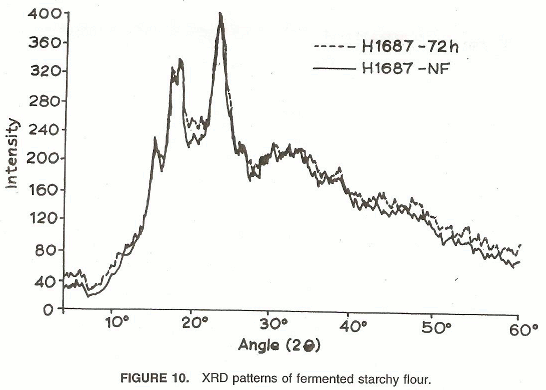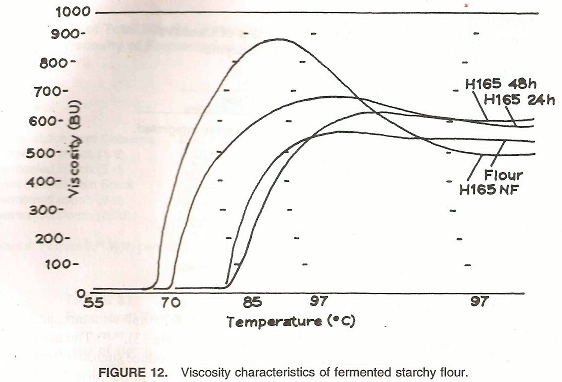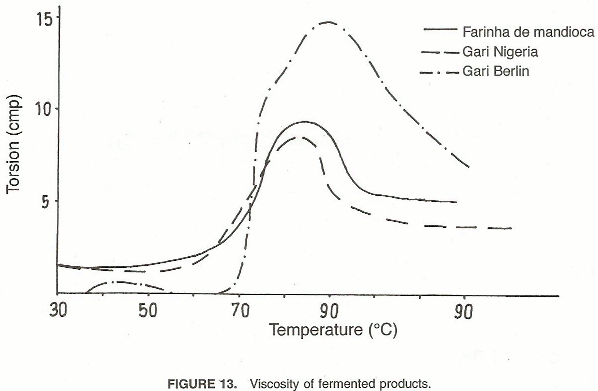Cassava Fermentation and Associated Changes in Physicochemical and Functional Properties
Prev Page | Next PageI. Starch Content
Changes in starch content during fermentation have also been studied. Here also the results are quite variable. According to Keitku et al., no significant change in starch content occurred during gari or Lafun fermentation,45 while a major reduction in starch content during fermentation for production of kpokpo gari and only minor reduction in fufu nd pukuru were noticed (Table 20).39 A reduction in starch content has been attributed to the conversion to sugars during fermentation.57 The starch content in different fermented products is presented in (Table 3).47
Table 25 : Mannitol Content of Cassava Tubers and Cassava-Based Food Stuffs
| Food Stuff | Source | Mannitol Contentmg/100 g dry weight | No. of Samples |
|---|---|---|---|
| gari grains | firo | 401 +48 | 5 |
| gari grains | ibadan city | 499 ± 94 | 20 |
| lafun | ibadan city | 329 ± 66 | 10 |
| fufu | ibadan city | 692 ± 84 | 10 |
| cassava tubers | university farm | 53 ± 1 | 18 cultivars |
Note: Mean values with standard deviations.
Source: Fafunso and Bassir.92
In our laboratory, the changes in starch content during fermentation with a mixed culture inoculum have been studied. It was observed that the decrease in starch was not significant in the initial stages. As there is enough sugar content for microbial utilization, the starch is not attacked by the organism. However, at later stages, when there is depletion of sugars, the organism starts breaking down the starch for sugar availability. (Tabl2 22).44
Table 26 : Effect of Fermentation on Sugar Content
Note: nd, not determined, detection limit 0.5 mg/g.
a Mannitol and glucose cochromatographed.
Source: Vasconselos.46
| Conc. Of sugar (mg/g dry matter) | ||||||||
|---|---|---|---|---|---|---|---|---|
| Fructose | Glucose/Mannitola | Sucrose | Maltose | |||||
| Time(d) | Fresh | Frozen | Fresh | Frozen | Fresh | Frozen | Fresh | Frozen |
| 0 | 5.0 | 5.4 | 6.5 | 7.3 | 14.5 | 11.9 | 0.7 | ND |
| 1 | 4.3 | 9.8 | 5.7 | 6.1 | 14.4 | 1.7 | ND | 0.8 |
| 2 | ND | ND | 15.5 | 11.7 | ND | 4.5 | 1.4 | ND |
| 3 | ND | ND | 10.7 | 18.0 | ND | ND | 1.4 | ND |
| 4 | ND | 0.7 | 13.3 | ND | ND | ND | 1.2 | ND |
V. Starch Properties
The effect of fermentation on starch characteristics has also been delineated. Cereda, in a series of publications, has outlined the effect of fermentation on various starch properties during production of polvilho azedo.93-100
A. Morphological Changes
Differences in the surface appearance of the sour starch from Colombia subjected to 20 to 30 d fermentation were observed under scanning electron microscopy.74,101 Numfor et al. have determined the average granule diameter of fermented and native starches dispersed in distilled water at different temperatures.67 No significant difference in average granule size was observed at 250C. However, 60 and 850C a decrease in average granule size was observed. The absence of any major change in morphology at 25oC indicates that corrosion of granule surface was minimal during the course of fermentation (Table 27). It was also shown that as fermentation time increased, some of the granules became smaller due to loss of superficial layers, while others remained intact.102
The microscopic evaluation of sour starch from Colombia and Brazil showed that most granules were undamaged. Split granules and those that had lost their birefringence were also present, but not predominant. The results were similar for different periods of fermentation.59
SEM studies revealed that there was no morphological change in starch extracted using an enzyme integrated technology (employing celluloytic and amyloytic enzymes) for starch extractin.103 Studies on the morphology of starch granules extracted from tubers fermented with mixed culture inoculum, showed that half of the granukes from fermented tubers were found to be clumped together as agglutinated granules of different shapes and sizes often adhering to hylane tubular materials. This result was confirmed in the SEM photographs, which also showed that many granules were adhering to each other probably due to electrostatic attraction between the granules that have undergone loss of superficial layer during fermentation (Figure 7 ). Other than this phenomenon, tehr was no major changes in granule surface morphology.44
Table 27 : Physical Properties of Commercial, Native, and Fermented Cassava Starches
| Type of cassava product starch | ||||
|---|---|---|---|---|
| Measured Variable | Commercial | Native | Natural Fermented | Fermented With culture |
| pHAv.granule diameter | 6.58 | 6.9 | 4.41 | 4.51 |
| 25o | 16.0 | 17.24 | 15.79 | 16.10 |
| 60o | 36.49 | 41.17 | 36.82 | 34.72 |
| 85o | 57.90 | 68.49 | 54.06 | 58.45 |
| Swelling power (g/g) | 27.32 | 28.70 | 25.22 | 24.26 |
| Solubility Gelatinization | 32.29 | 29.71 | 21.83 | 18.48 |
| Onset temp 0C | 68.40 | 67.67 | 66.77 | 69.08 |
| Peak temp. 0C | 74.69 | 73.04 | 72.60 | 73.99 |
| Enthalpy (mJ/mg) | 12.75 | 12.75 | 14.42 | 14.46 |
Adapted from Numfor.67
B. Amylose Contents
Fermentation has been reported to reduce amylase content.72 the organic acids produced during fermentation complex with the soluble amylase fraction thereby leading to an apparent reduction in soluble amylase fraction thereby leading to an apparent reduction in soluble amylase content. This complexation leads to enhancement in gelatinization temperature and also enhancement in fufu qualities, as the stickiness due to soluble amylase has been lowered. However, such a reduction in amylase content was nto noticed by other workers.40, 102
An observed increase in amylase content both in lab-fermented and native-fermented samples has been explained as due to formation of amylase-like material resulting from enzyme/acid hydrolysis of amylopectin in the amorphous regions of starch granules.67
Our results on fermentation using mixed culture inoculum indicated that the apparent reduction occurring in total and soluble amylase contents was due to the reduced starch content in the extracted starchy flour.85
C. Molecular Weight
The molecular weights of sour starch obtained by fermentation ( 20 to 30 d) and acid treatment ( 20 to 30 d) and native starch have been compared.74,101 The sour starch obtained through fermentation showed a considerable reduction in molecular weight compared with acid-treated starch, showing that fermented starch undergone much higher breakdown.
A.Crystallinity
The X-ray diffraction (XRD) pattern of nonfermented and fermented cassava starches were nearly similar.40,59 Similar results were obtained in the starch extracted by enzyme integrated conventional method.103 The XRD patterns of the starchy flour obtained from nonfermented and fermented cassava did not reveal any difference showing that the crystalline nature of the starch fraction remained unaffected (Figure 10)85 in conformity with other results.40
E. DSC Characteristics
The thermal characteristics of fermented starch have been investigated in detail. There was only one endothermic transition at high water content (3.1 to 4.2 times)59. the Tmax were 69.6o for laboratory prepared non-fermented starch, 72.70 for industrial sweet starch, and 67.01 0C for fermented starch. The results showed that gelatinization temperatures were reduced by fermentation. No difference among the different periods of fermentation was observed. The final temperature also showed the same trend. At low water contents (1 to 0.4 ratio ) two endothermic transitions were observed, first for starch gelatinization and second fro melting. No peak for any amylaseilipid complex was detected at high or low water contents. On addition of lipids, the amount of complex was higher in fermented starch. DSC of these complexes showed an endotherm corresponding to dissolutions of amylose-lipid complex with a maximum temperature of 106 and 109 0C for nonfermented and fermented samples respectively. The H for dissolutions were 19.6 J/g of starch for fermented and 14.64 J/g of starch for nonfermented starch, respectively.
Graph No. 107 (Fig 10)

Similar studies on fermented starch indicated that onset of gelatinization remained unchanged, while gelatinization enthalpy increased by 13.1 and 13.41% respectively, in natural fermented and mixed culture fermented starches. Higher enthalpy and temperature of gelatinization are explained to be due to formation of new hydrogen bonds leading to higher stability.67
DSC data on starchy flour extracted from nonfermented and fermented samples of two varities (H-1687 and T-300) showed that the initial, maximum and final temperatures were enhanced in case of fermented samples (Table 29, Figure 11)85. The delayed gelatinization is attributed to presence of fiber in the starchy flour which prevents easy entry of water molecules. The enthalpy off gelatinization also showed a slight declinic in the fermented samples. The reduction in enthalpy is due to reduced starch content in the fermented samples.
| Fermentation time (h) | ||||
|---|---|---|---|---|
| 0 | 24 | 48 | 72 | |
| Temperature (0C) | ||||
| H 1687 | ||||
| Intial | 70.12 | 72.72 | 72.34 | – |
| Maximal | 73.99 | 77.60 | 75.52 | – |
| Final | 80.69 | 82.24 | 81.21 | – |
| Enthalpy J g-1 | 2.03 | 1.78 | 1.35 | |
| T 300 | ||||
| Initial | 69.12 | 70.97 | 69.49 | 69.60 |
| Maximal | 71.87 | 73.85 | 72.67 | 73.44 |
| Final | 75.27 | 79.89 | 80.44 | 78.94 |
| Enthalpy J g-1 | 1.86 | 1.67 | 1.46 | 1.37 |
E. Viscosity Characteristics
Comparative studies on the viscosity patterns of sweet, acid-modified, and sour ( 20 to 30 d fermented ) starches revealed that the peak viscosity was considerably lowered in sour as well as acid-modified starch, indicating extensive thinning.74,101
Table 28
DSC Data (0C) of Flour from Fermentation and Nonfermented Tubers
| Fermentation time (h) | ||||
|---|---|---|---|---|
| 0 | 24 | 48 | 72 | |
| Temperature (0C) | ||||
| H 1687 | ||||
| Initial | 70.12 | 72.72 | 72.34 | – |
| Maximal | 73.99 | 77.60 | 75.52 | – |
| Final | 80.69 | 82.24 | 81.21 | – |
| Enthalpy Jg-1 | 2.03 | 1.78 | 1.35 | – |
| T 300 | ||||
| Initial | 69.12 | 70.97 | 69.49 | 69.60 |
| Maximal | 71.87 | 73.85 | 72.67 | 73.44 |
| Final | 75.27 | 79.89 | 80.44 | 78.94 |
| Enthalpy Jg-1 | 1.86 | 1.67 | 1.46 | 1.37 |
Source: Moorthy et al.85
Two samples of fermented starch used for production of polvilho de azedo in Brazil differed with respect to Brabender viscosity and it was found that starch having higher biscuit volume had lower viscosity with higher retrogradation power.100 Effect of released organic acids on the Brabender Viscographic pattern of fermented starch and aqueous suspension of fufu has also been documented.72
The rheological properties of starch during different types of fermentation have been examined in detail (Table 29)67 Starch fermented with culture had a slightly higher pasting temperature compared with native and naturally fermented starches. Temperature at peak viscosity was increased in both fermentations, while peak breakdown and set back viscosity were reduced by the fermentations. An effort was also made to study the role of pH on the pasting properties. No effect was observed until a pH of 4.5 was used. However, at pH 3.5, the peak viscosity was reduced slightly. It is suggested that the rheological changes reflect the internal stability of the fermented starch granules, resulting in reduced swelling and leaching of amylose.
Fig. 11

Table 29 : Pasting characteristics of Native or Fermented Cassava
| Type of Cassava | |||
|---|---|---|---|
| Measured Variablea | Native | Fermented Naturally | Fermented with Culture |
| Pasting temperature (0C) | 42 | 42 | 43.5 |
| Peak viscosity temperature(0C) | 63 | 69 | 72 |
| Peak viscosity (BU) | 1070 | 770 | 850 |
| Breakdown viscosity (BU) | 575 | 310 | 360 |
| Setback viscosity (BU) | 275 | 290 | 230 |
a Each value represents a mean of two sample determinations
Adapted from Numfor.67
A reduction in peak viscosity during polvilho azedo preparation104 and laboratory fermentation105 has also been reported. The viscosity characteristics of fermented starch have been investigated using a Haake viscometer59 and the Brabender amylograph.40 In both studies, reduced viscosity was observed for fermented starch and the lower paste viscosity is considered to be due to greater solubility of fermented starch in hot water. The structural modification affect the functional properties depending on time of fermentation and temperature. The viscosity indices of enzyme integrated conventionally extracted starch were found to be slightly decreased compared with those of traditionally extracted samples (Table 30).103
The results of fermentation using mixed culture inoculum in our laboratory showed that the starch obtained by fermentation exhibited lower viscosity and the peak viscosity progressively reduced with increase in time of fermentation (Figure 12).85 The lowering of viscosity was due to the reduced starch content in the extracted starchy flour, as a considerable quantity of fiber accompanied the starch. Although the peak viscosity was lowered, the viscosity was mush more stable. The presence of fibrous material seems to stabilize the viscosity by cementing the starch granules against breakdown due to heat and shear. This is also confirmed by the enhanced pasting temperature of the starchy flour extracted from fermented tubers. The influence of fiber on viscosity characteristics of starch has also been indicated earlier.72 The viscosity characteristics of some fermented cassava products are presented in Figure 13.
Table 30 : Pasting Characteristics of Cassava Starches Obtained by Conventional and Enzyme-Integrated Conventional Methodsa
| Recovery Method | ||
|---|---|---|
| Property | Conventional | Enzyme-Integrated |
| Pasting temp. (0C) | 71.0 | 71.0 |
| Percent slurry | 7.0 | 7.0 |
| Peak viscosity (P) BU | 730 | 690 |
| Hot-paste viscosity (H) BU | 510 | 450 |
| Cold-paste viscosity (C) BU | 660 | 590 |
| Setback viscosity (C-P) BU | -70 | -100 |
| Total set-back, SB( C-H) BU | 150 | 140 |
| Break down, BD (P-H) BU | 220 | 240 |
| Relative breakdown BDr=BD/sBt | 1.46 | 1.71 |
a Calculated from the data as read from the Brabender viscograph. BU = Brabender Units
Source : Padmanabhan and Lonsane.103
G. Swelling Power
Studies on the effect of dice size, fermentation time, blanching, and drying temperature on swelling capacity of gari revealed that gari from 1-cm cubes, fermented for 3 d, blanched for 10 min, and dried at 55oC had higher swelling capacity needed for most acceptable gari quality.106
Swelling power was reduced to the extent of 12.1% in natural fermentation and 15.5% in inoculum provided fermentation.67 This property is explained on the basis of weakening of associative forces in the granules, especially in the amorphous regions. Starch fermentation to polvilho azedo has been reported to lead to enhanced swelling,40,104 which is contrast to other results.
In enzyme-integrated extraction of cassava starch, it was observed that swelling volume and swelling power were lowered for the extracted starch (Table 31).103 The effect has been explained as due to lowering of pH in the enzyme-integrated method.
Figure 12

Figure 13

The swelling volumes of starch extended from fermented tubers were found to be invariably lowered. The reduction is attributable to the greater solubility of the fermented starch as well as the presence of fibrous residues, which can restrict swelling.85
Table 31 : Physiochemical and Functional Propertied of Cassava Starches Obtained by Conventional and Enzyme Integrated Method
| Starch Type | ||
|---|---|---|
| Property | Conventional | Enzyme-Integrated |
| pH | 4.40 | 4.0 |
| Acidity (meq/g) | 0.05 | 0.06 |
| Water Binding Capacity | 74.30 | 73.40 |
| Water Solubility | 0.88 | 1.46 |
| Swelling Power | 2.0 | 1.60 |
| Swelling Volume | 12.4 | 10.0 |
Adapted from Padmanabhan and Lonsane.103
H. Solubility
The solubility of starch was reduced by 26.5 and 37.8% respectively, during natural fermentation and mixed culture fermentation. The reduction in solubility has been explained to be due to alteration in the internal granule structure following enzyme/acid action.67
An increase in solubility of fermented starch has also been observed by Petrucelli et al.,59 and the result has been explained on the basis of internal structural modifications. Similar results were also obtained in the enzyme-integrated extraction of starch103 and during fermentation of starch for polvilho azedo preparation (Table 32).59


